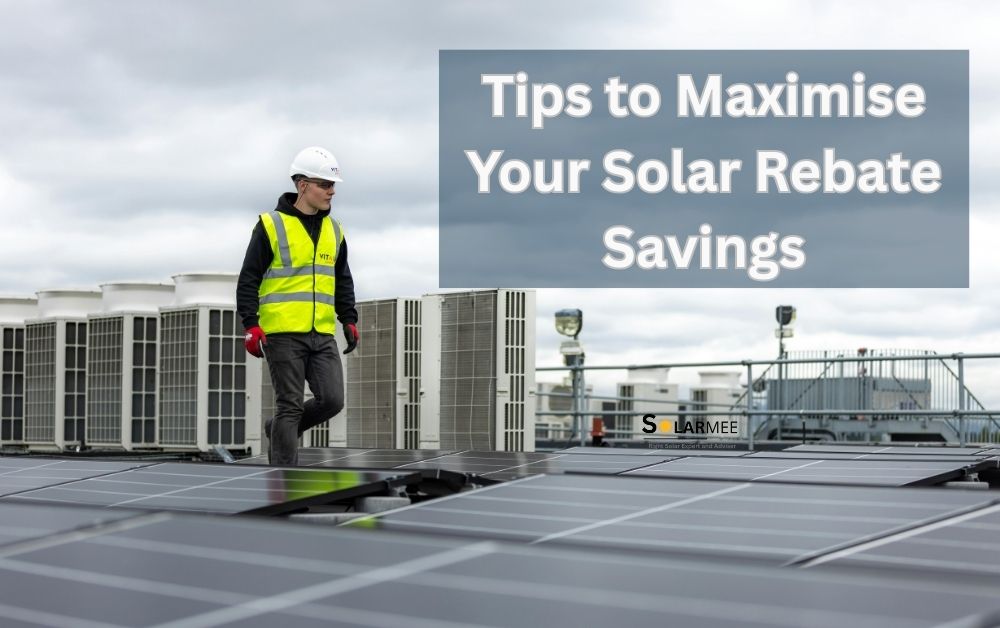Western Australia’s solar energy adoption is flourishing with vigor. The residential and commercial sectors are flooded with a choice of solar panels that achieve a dual goal: reducing their electricity bills and CO2 emissions. By 2025, the state-installed solar was able to hit the 5.6 gigawatt mark, thus becoming a leader in the microgrid and community solar farm sectors, which are considered the most innovative models in the field of clean energy.
Solar panel rebate programs are a significant contributor to the affordability of solar energy through the initial discounts and small-scale schemes offered to both homeowners and businesses. The rebates not only reduce the installation costs but also strongly contribute to WA’s renewable energy goals.
This handbook provides readers with a detailed description and criteria of government incentives for solar energy, hints and instructions on how to maximize the value of the presented rebate, and an unbiased, thorough, and even-handed review of the WA solar panel rebate program in real life.
Solar Panel Rebate in Western Australia
A solar panel rebate is a cash incentive that goes a long way in reducing the total cost of installing solar panels in Western Australia. This, in turn, makes renewable energy more affordable and accessible to the people of WA. The main Australian rebate system is based on the federal Small-scale Renewable Energy Scheme (SRES).
The scheme awards the residential sector with Small-scale Technology Certificates (STCs) as on-the-spot purchase rebates—usually lowering the cost of a 6.6kW solar system to $2,000–$2,500.
Moreover, Western Australia has certain local advantages, for instance, a feed-in tariff for energy exported and the 2025 Residential Battery Rebate (a maximum of $7,500), but there is no direct panel rebate from the state. The short-form title of the battery and the STC rebate,
The money, which goes right into the installer’s or retailer’s hand, is given to them for the customer’s invoice without having to undergo any complicated paperwork. There could be some additional council incentives in your local community, which might offer you further benefits in your area.
Also Read: Understanding Solar Panel Rebates in Australia
Who is Eligible for Solar Rebates?
Solar rebates eligibility in Western Australia depends on the rules of both federal and state programs. Most solar panel installations in households qualify if they are the owners or residents of a home connected to the grid, use a Clean Energy Council-accredited installer, and pick products from the approved lists.
Generally, the main federal Small-scale Technology Certificates (STCs) do not have an income threshold and are given out everywhere if the system is new and meets the standards. On the other hand, state battery rebates may have requirements such as being a Synergy or Horizon Power customer and installing batteries with a certain capacity or VPP readiness.
The difference between “who can get a solar rebate” and “solar panel rebate Australia eligibility” is that the first one talks about the requirements that need to be fulfilled to participate in a certain program, and the second one refers to a program called STC that is spread throughout Australia with no limitations by location or income.

How to Claim Your Solar Panel Rebate in Western Australia
| Step | Action | Details & Notes |
| 1. Research approved installers | Find Clean Energy Council-accredited providers | Choose experienced local installers; accreditation is required for any solar panel rebate. |
| 2. Get multiple quotes | Compare costs and service inclusions | Request detailed quotes to check pricing, brands, and rebate pass-through options. |
| 3. Confirm eligibility | Ensure the property and installation meet the criteria | Installer checks STC eligibility and compliance with the grid, product, and residential status. |
| 4. Apply via the installer/government | Complete paperwork | Most installers submit STC paperwork; local council rebates may need extra online forms. |
| 5. Install system & receive rebate | Proceed with the approved install | Installer finalises setup; rebate or STC value is usually discounted upfront or paid out by SolarQuotes. |
Benefits of Solar Rebates for Western Australian Households
Solar rebates represent a substantial advantage to households in Western Australia as they considerably reduce the initial installation cost of solar panel systems. The federal Small-scale Renewable Energy Scheme (SRES), for instance, delivers rebates of approximately $2,500 for a standard 6.6kW system in WA; thus, the payback period is shortened, and the return on the investment is increased.
Moreover, the WA Residential Battery Rebate just launched gives a big help in lowering the cost of batteries as well as enabling families to have the excess solar energy stored for use when the solar energy is not available. These incentives, too, can substantially help achieve Western Australia’s renewable energy goals, which is a result of the clean energy technologies being encouraged.
A household that has both solar and battery storage is allowed to save up to $1,500 annually, which makes the use of solar energy a wise decision financially as well as environmentally.
Comparing Western Australia Rebates with Other States
Western Australia gives good solar rebates that are mostly from the federal government programs, such as the Small-scale Renewable Energy Scheme (SRES), which is about $2,300 off a 6.6kW system. Furthermore, the state has battery rebates of up to $7,500 and interest-free loans, in addition to the feed-in tariffs.
Solar Homes Program in Victoria is much more generous with the state’s rebates going as high as $1,400 on top of the federal subsidies, plus interest-free loans and healthy feed-in tariffs that make solar very affordable and accessible. The incentives in Queensland consist of STCs along with the Cheaper Home Batteries Program and regional feed-in tariffs, which enable a large upfront discount and continual savings.
In comparison with the VIC and QLD, WA’s rebates are still competitive, but they are less extensive and put more emphasis on the battery support.

Tips to Maximise Your Solar Rebate Savings
In order to get the most out of your solar rebate in Western Australia, it is recommended that you first determine the best size of the system that would be able to meet the energy needs of your household. Normally, the size is between 6.6kW and 10kW for most homes.
Make sure that your system is installed by an installer who has been accredited by the Clean Energy Council (CEC) so that you can be doubly certain that you will be entitled to government rebates and also that there will be quality assurance. Using the installation rebate as the base, you can combine it with other available incentives such as feed-in tariffs and green loans with low-interest rates to give you a bigger saving.
There are certain things that you need to avoid if you want to enjoy the solar rebates, for example, do not choose solar panels that are cheap and not approved, and do not hire the services of an installer who is not experienced. It is very important to plan well and use the incentives that are available to you in order to get the most out of your solar investment. ,
Real Reviews & Experiences from Western Australian Households
Solar panel rebates in Western Australian households are generally positive and are mainly associated with considerable savings and easy processes when they work with trusted local installers. A lot of them enjoy the rebate discounts given at the time of purchase by the federal Small-scale Technology Certificates (STCs), which are the main reason for the affordability of solar installations.
Customers also give the services of energy providers like Synergy a five-star rating in terms of the ease of their coordination. But the problem they face is the occasional delays in the completion of the paperwork and the misunderstanding of state versus federal rebate rules, which trigger small troubles in the application process.
Some installers have had difficulties due to the changes in battery rebate requirements, which have consequently led to the slowing down of the timelines. Generally, solar rebate programs in Western Australia are viewed as the main motivation for going solar, with a large potential for savings; however, there are some issues with administration and communication in the implementation of these programs.
Future of Solar Rebates in Western Australia
The future of solar rebates in Western Australia depends on exciting government projects that aim to speed up the use of clean energy. The WA Residential Battery Scheme, which starts on 1st July 2025, provides rebates of up to $5,000 for qualifying battery installations, thereby facilitating about 19,000 homes to participate.
This works together with the federal Cheaper Home Batteries Program that offers 30% off the cost of solar battery systems to the whole country. Although the solar panel subsidies under the federal Small-scale Renewable Energy Scheme (SRES) will be gradually phased out until 2030, the battery rebates and the offer of an interest-free loan will still provide the necessary incentives.
The experts of the industry forecast that the development will continue as a result of the battery storage acceptance and the use of energy by means of the integration of different sources, with the rebates now being used for both grid stability and household energy independence.
Also Read: What is a Solar Panel Rebate?
Conclusion
Western Australia also has solar panel rebates that can be really valuable and most of those are offered through the federal Small-scale Renewable Energy Scheme (SRES). These are basically upfront discounts that can go up to about $2,300 for a 6.6kW system. In addition, the state is providing the WA Residential Battery Rebate and is offering low or even zero-interest loans.
They are a great way to attract new customers to the renewable energy market and to reduce their expenses considerably. These incentives not only shorten the payback periods but also assist the homeowners in becoming completely energy independent.
To really make your savings as big as possible, you should choose the right size system, employ the services of CEC-accredited installers, and use the rebates together with other incentives that you may have. While most of the testimonials hail the money-saving aspect, a few of them also mention the fact that they have experienced some delays during the paperwork process.
As the rebates might be reduced in the future, it is always better to consider the potential of being eligible and then acting fast. So please don’t delay, talk to a certified solar installer right away, and enjoy your Western Australia solar panel rebate!

I am Vanshika, a passionate writer, digital marketer, and explorer of ideas. With expertise in SEO, social media, content creation, and website design, I combine creativity with strategy to deliver impactful digital solutions. Writing is my way of sharing knowledge, sparking curiosity, and building meaningful connections with readers. Through my blog Vanshi’s Exploration, I share unique insights on finance, travel, technology, and future-forward thoughts that inspire and inform.




